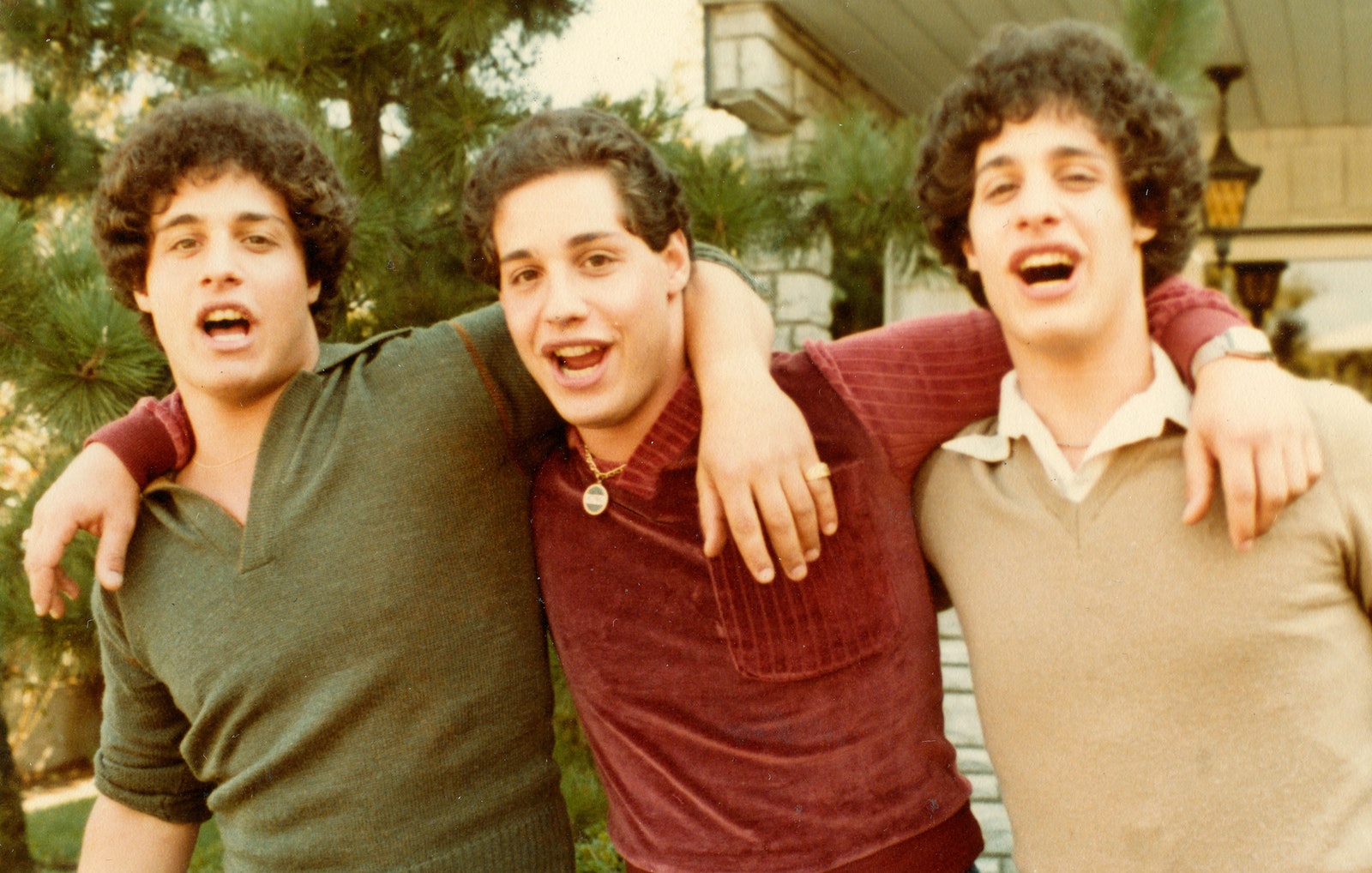

The documentary Three identical strangers, directed by Tim Wardle, starts like a feel-good movie where three long lost brothers find each other and immediately hit it off. It is the fall of 1980 when the 19-year-old Robert Shafran, who just started his studies in New York, finds out he has a twin brother, Edward Galland. When this news hits the local newspaper, David Kellman can’t believe his eyes looking at a picture of two boys who look exactly like him. It turns out Robert and Edward aren’t just twin brothers, they form triplets together with David. The three guys are oddly alike and feel an immediate affection for one another. They visit each others houses and call each others parents ‘mum, mum, mum and dad, dad, dad’. They talk about girls they dated, the brands of cigarettes they liked and parties they went to. It turns out they all smoked the same brand of cigarettes, wrestled in high school, had the same taste in girls and had similar mental difficulties growing up.
The entire United States was enthralled by the story. The guys were invited to a lot of TV shows and interviews and even had a small part in Madonna’s film Desperately seeking Susan. They had their own apartment called ‘the triplet apartment’, which was like a bachelor apartment but worse and owned a restaurant for a while called ‘The triplets’, where people came specially to see them. It was like they were living in a dream.
However, about halfway through, the documentary takes a dark turn when the guys’ parents start questioning why the triplets were separated at birth and aren’t able to find many answers. After lots of investigation, they find out the triplets were part of a study on monozygotic twins and triplets. They were separated at birth to study the effects of parenting. Unfortunately, a lot of questions remain unanswered. The adoption center isn’t really helpful, most people that were part of the research team don’t want to talk to the triplets and the head researcher, Neubauer, had the data of the study sealed at Yale University until 2065 before he passed away in 2008.
This documentary feels so surreal, that while watching you have to keep telling yourself that this is a real-life story. It’s hard to imagine an adoption center separating you from you siblings all for the purpose of science, isn’t it? The only thing that makes this documentary credible is that the triplets and their loved ones are the narrators of this story.
As psychology students, we might all secretly want to design a study like this to put an end to the nature versus nurture debate. This was exactly what Neubauer tried to do: he wanted to solve this debate and made this ‘wish’ come true, but with that he greatly violated the ethical codes. Unfortunately, this study didn’t help to bring the debate any further. While the guys initially seemed oddly alike, this similarity only existed on a surface level, and they soon found differences in upbringing and amongst themselves. Besides, most of the data isn’t available, and the data that is available is very confusing.
This documentary lets you travel through the heartbreaking story of triplets who were separated at birth and found each other by chance years later. Three identical strangers also makes you question how far you would go for science, and gets you to think about the nature versus nurture debate once again. Although the documentary seems somewhat embroidered at times, I would recommend it.
This movie is out now in a cinema near you.

The documentary Three identical strangers, directed by Tim Wardle, starts like a feel-good movie where three long lost brothers find each other and immediately hit it off. It is the fall of 1980 when the 19-year-old Robert Shafran, who just started his studies in New York, finds out he has a twin brother, Edward Galland. When this news hits the local newspaper, David Kellman can’t believe his eyes looking at a picture of two boys who look exactly like him. It turns out Robert and Edward aren’t just twin brothers, they form triplets together with David. The three guys are oddly alike and feel an immediate affection for one another. They visit each others houses and call each others parents ‘mum, mum, mum and dad, dad, dad’. They talk about girls they dated, the brands of cigarettes they liked and parties they went to. It turns out they all smoked the same brand of cigarettes, wrestled in high school, had the same taste in girls and had similar mental difficulties growing up.
The entire United States was enthralled by the story. The guys were invited to a lot of TV shows and interviews and even had a small part in Madonna’s film Desperately seeking Susan. They had their own apartment called ‘the triplet apartment’, which was like a bachelor apartment but worse and owned a restaurant for a while called ‘The triplets’, where people came specially to see them. It was like they were living in a dream.
However, about halfway through, the documentary takes a dark turn when the guys’ parents start questioning why the triplets were separated at birth and aren’t able to find many answers. After lots of investigation, they find out the triplets were part of a study on monozygotic twins and triplets. They were separated at birth to study the effects of parenting. Unfortunately, a lot of questions remain unanswered. The adoption center isn’t really helpful, most people that were part of the research team don’t want to talk to the triplets and the head researcher, Neubauer, had the data of the study sealed at Yale University until 2065 before he passed away in 2008.
This documentary feels so surreal, that while watching you have to keep telling yourself that this is a real-life story. It’s hard to imagine an adoption center separating you from you siblings all for the purpose of science, isn’t it? The only thing that makes this documentary credible is that the triplets and their loved ones are the narrators of this story.
As psychology students, we might all secretly want to design a study like this to put an end to the nature versus nurture debate. This was exactly what Neubauer tried to do: he wanted to solve this debate and made this ‘wish’ come true, but with that he greatly violated the ethical codes. Unfortunately, this study didn’t help to bring the debate any further. While the guys initially seemed oddly alike, this similarity only existed on a surface level, and they soon found differences in upbringing and amongst themselves. Besides, most of the data isn’t available, and the data that is available is very confusing.
This documentary lets you travel through the heartbreaking story of triplets who were separated at birth and found each other by chance years later. Three identical strangers also makes you question how far you would go for science, and gets you to think about the nature versus nurture debate once again. Although the documentary seems somewhat embroidered at times, I would recommend it.
This movie is out now in a cinema near you.



